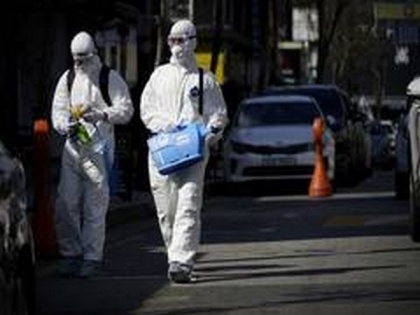Blacks, Hispanics account for most deaths of COVID-19 victims under 21 in US
By ANI | Published: September 16, 2020 05:00 AM2020-09-16T05:00:34+5:302020-09-16T05:15:02+5:30
Hispanics, Blacks and native Americans suffered nearly 80 per cent of the COVID-19-related deaths among victims who were under 21-years-old, which totalled 121 from February 12-July 31, the Centers for Disease Control and Prevention (CDC) said in its Morbidity and Mortality Weekly Report on Tuesday (local time).

Blacks, Hispanics account for most deaths of COVID-19 victims under 21 in US
Hispcs, Blacks and native Americans suffered nearly 80 per cent of the COVID-19-related deaths among victims who were under 21-years-old, which totalled 121 from February 12-July 31, the Centers for Disease Control and Prevention (CDC) said in its Morbidity and Mortality Weekly Report on Tuesday (local time).
"Among 121 SARS-CoV-2-associated deaths reported to CDC among persons aged less than 21 years ... 45 per cent were Hispc persons, 29 per cent were non-Hispc Black (Black) persons, and 4 per cent were non-Hispc American Indian or Alaska Native (AI/AN) persons," the report said.
Minorities represent 78 per cent of the deaths although they comprise 41 per cent of the under 21 population, the report said.
Possible reasons include the elevated presence in households of essential workers unable to work from their homes, resulting in higher exposure to the disease, the report said.
"Disparities in social determinants of health, such as crowded living conditions, food and housing insecurity, wealth and educational gaps, and racial discrimination, likely contribute to racial and ethnic disparities in COVID-19 and MIS-C incidence and outcomes," the report added.
MIS-C or multisystem inflammatory syndrome refers to a rare but severe complication from COVID-19 infections found in children and young adults.
Another possible reason is that racial and ethnic minorities are disproportionately represented among essential workers who are unable to work from home, resulting in higher risk for secondary transmission among household members, the report said.
Higher rates of adverse outcomes among racial and ethnic minorities are likely related to challenges in seeking care, including difficulty and delays in accessing medical services because of lack of insurance, child care, transportation, or paid sick leave, the report added. (/Sputnik)
( With inputs from ANI )
Disclaimer: This post has been auto-published from an agency feed without any modifications to the text and has not been reviewed by an editor
Open in app